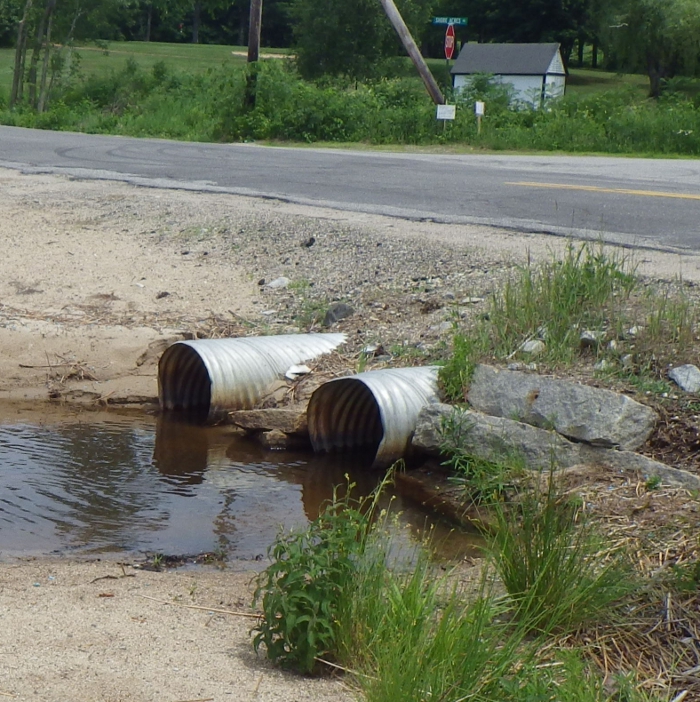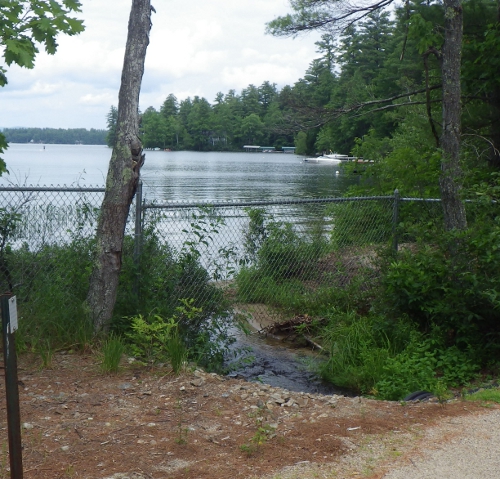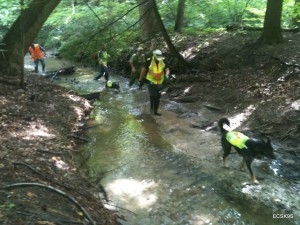Water Quality Monitoring of Province Lake
Effingham & Wakefield, New Hampshire, and Parsonsfield, Maine
Expanded version of Item 10 in 2013 Report regarding E. coli
- Published Online on July 16, 2014
10. Much E.coli bacteria testing (22 samples) was done in 2013 as part of the study for the Province Lake Watershed Management Plan. Of the 22 E.coli samples, 5 exceeded the strictest NH DES health advisory level for public beaches.
Two of the highest readings occurred at the stream that drains into Province Lake at the beach along Rt. 153 near Shore Acres Road in Maine, shown below. High results were >2000 counts per 100 milliliters (which I will call "Counts") on 7/11/13 and 430 Counts on 8/14/13. Another high reading was 920 Counts at the Island Inlet on 7/11/13. The lowest two high readings were 130 Counts on 6/5/13 at the Island Inlet and 120 Counts on 6/20/13 at Hobbs Brook.
It is NH DES's opinion that the high readings are likely due to wildlife sources (ducks, geese, beavers, etc.); however, it is important to rule out human sources. The reason for this is that while E.coli is unhealthy to have in the water, we test for it primarily as an indicator of contamination by human sewage. Viruses and bacteria that may be present in human sewage are the main pathogens that we are concerned about, but there are very many of them and they can be difficult to test for directly. Therefore, we test for E.coli, which is cheap and easy to do. The down-side is that E.coli measurements may be boosted by E.coli from wildlife, which may falsely raise concern to too high a level. Some viruses, bacteria, and parasites from wildlife sources are likely less adapted to infecting humans, though they are still not to be ignored. Swimmer's itch is a good example of effects humans can experience from swimming in water near ducks. It is one reason why it is a bad idea to feed ducks in your swimming area.
According to DES, source tracking and additional sampling will be conducted at the sites with high readings to determine if there are chronic problems; bacteria levels are highly variable, so additional sampling is needed to better understand what is going on at these sites. There is no evidence that the golf course upstream has done anything wrong. Wildlife are almost certainly the source of the E. coli at that stream, although that reason does not necessarily make the E. coli concentrations safe. This will be a focus of future efforts to improve water quality. Local volunteers will be needed to assist in this effort.
According to the owner of Province Lake Golf course the E. coli count is in no manner indicative of or related to Province Lake Golf course, since there are NO human waste sources associated anywhere near the stream that are associated with the golf course. He highlights the large population of geese and ducks that live there, not to mention the deer, moose, bears, and other wildlife that live in the woods upstream.
Other inflows that were sampled and were lower than the strictest NH DES beach advisory level (88 Counts) were the Rt. 153 Inlet that drains the large wetland in NH near the state line (40-70 Counts) and the campground brook (10-40 Counts, measured at Remick Road, upstream of the Province Shores Campground).
The 2 streams with the highest readings have low enough flows that it is likely that any E.coli there will have little or no effect on the overall lake water quality. However, the stream on Rt. 153 in Maine enters the lake at the heavily used beach on private land near Shore Acres Road and should be treated with caution. The outflowing stream should be considered an "attractive nuisance" and adults should actively keep their children away from it. If it has been raining recently and you see that water is flowing into the lake at that location, it would be best to avoid swimming too close to it. Since the Maine beach is on private land, you should not expect there to be government monitoring or health postings. You must use your own judgment.
Those with private beaches near the Island Inlet, shown here [click it for full view], should also be cautious. Generally, it is probably best to avoid swimming in any streams as they flow into the lake, since even those with E.coli levels considered safe had measurable amounts of bacteria. And it is always best to avoid swallowing lake water.
The above commentary has been modified from earlier drafts based on detailed comments from Sally Soule of the NH DES Watershed Assistance Section, who is part of the Watershed Management Plan Team. Her comments are comprehensive and clear, so deserve to be presented with minimal editing. Comments below in [square brackets] are from me, not Sally.
NH DES comments from Sally Soule (remainder of this page)
1. Interpreting results:
While it is a concern that some high levels were found at the tributaries, it is also important to note that bacteria can be a highly variable parameter and often, more sampling and source tracking are needed to determine whether there is a chronic problem at a site. That being said, the 2000 and 920 count readings may be of concern and considering that both samples were collected following a rain storm (defined as 0.26" during the 24 hour period before sampling). This could indicate that the bacteria is finding its way to the lake in runoff from the surrounding watershed. Source tracking and additional sampling is needed to define the problem.
[In fact, records from my digital rain gage indicate that the >2000 Count result at the Maine beach and the 920 Count result at the Island Inlet on 7/11/13 followed 0.74" rain that started~ 5:30 PM on 7/10/13. The 430 Count result at the Maine beach on 8/14/13 followed 0.56" rain the afternoon of 8/13/13. ]
2. Source Tracking:
At this point, it is our opinion that the high readings are likely due to wildlife sources (geese, ducks, beavers, etc.); however, it is important to rule out human sources. The Province Lake Association is applying for funding to conduct special source tracking studies at sites with higher bacteria levels. This type of tracking utilizes dogs trained to sniff out human sources of bacteria. If human sources are detected, steps will be taken to pin point and address the source. If human sources are not detected, follow-up field work will be conducted to track down the sources and address them.
3. Beach Advisories:
In NH, if high levels of bacteria are detected at a swimming beach, DES works with the local health officer or beach manager to determine how to "post" beach advisories or closures. Here's a link to NH's Beach Program web site; it explains how advisories are issued.
4. State Water Quality Thresholds:
a. Maine E.coli standards:
are established "...as 64 [Counts] for the geometric mean of E.coli and 236 [Counts] instantaneous for Class B waters;... as 29 [Counts] geometric mean of E.coli and 194 [Counts] instantaneous for lakes."
b. New Hampshire: When is a Beach Advisory posted?
At a freshwater beach, an advisory is posted if two or more samples collected at a beach exceed the state standard of 88 Counts of water OR when one sample exceeds 158 Counts of E.coli.
[Sally was asked: "Why do NH and Maine have different standards?"]
You've asked a good question about the water quality standards. It comes up a lot and the answer lies in how the federal Clean Water Act (CWA) is structured. Basically, the CWA requires each state to develop water quality standards for meeting CWA requirements. The result is that each state has different standards... and that is why Maine is different from NH. EPA reviews and signs-off on state water quality standards, however. It's a bit of a good/bad situation in that individual states have control over how they want to meet the CWA, but on the other hand, it can make things complicated when dealing with cross-border water quality issues.
5. Follow-up Monitoring:
The Province Lake Association is applying for funding to conduct additional monitoring for several parameters, including bacteria. However, it is important to note that volunteers are needed to help with this effort. Both states are strapped for funding and staff time; therefore, local volunteers are needed to collect data about their water bodies.
Steve Craig, the lake's volunteer water quality monitor, conducted or assisted DES with all the 2013 sampling. The PLA and DES shared the costs of sample analysis. I just want to make sure that folks understand that volunteers like Steve have been so critical to this effort; without his help, we could not have done the tributary sampling as effectively; loyal volunteers, like Steve and other members of the Province Lake community, who are willing to get out there and help will be needed as this effort moves forward into the implementation phase of the project.
6. Coordination:
Due to the collaborative nature of the Province Lake Watershed Planning Project, both states and the watershed towns are involved in the project and will work with the Province Lake Association over the coming years to implement recommendations from the watershed plan (including tracking sources of pollution).
7. Message to the Public:
This brochure from the Maine Healthy Beaches program includes some effective language for educating swimmers about potential risks of swimming in contaminated waters. I think it provides language that is cautionary, but not alarmist. [Note that it is not formatted very well for computer and is best printed out and folded.]
Addressing sources of high bacteria is critical to protecting the health and safety of swimmers and recreationalists. However, I think it's important for folks to have a realistic and practical understanding of the length of time, costs, labor, and local involvement needed to track and resolve sources; follow-up source tracking and sampling can be costly, labor intensive, and it could potentially take awhile to resolve issues. Additionally, coordination and cooperation from state and local officials, along with landowners, will be needed to implement solutions.
BACK TO THE MAIN 2013 REPORT
Legal Disclaimer: I am a degreed environmental engineer, licensed in Maine and other states, but my communications on this topic are educational in nature. Due to my professional engineering licenses, I am required to say that this communication does not constitute engineering work, even when using my engineering knowledge. I do not speak for anyone but myself, in the form of my company, E and I Services, LLC.
Terms of Use: Anyone is allowed, even encouraged, to link to this page. However, no one is authorized by the author
or by E and I Services, LLC
to copy the content and post it on another web site.
This web site is owned by E and I Services, LLC and has no affiliation with any other organization.
Copyright © 2015-2017 by E and I Services, LLC. All rights reserved.


